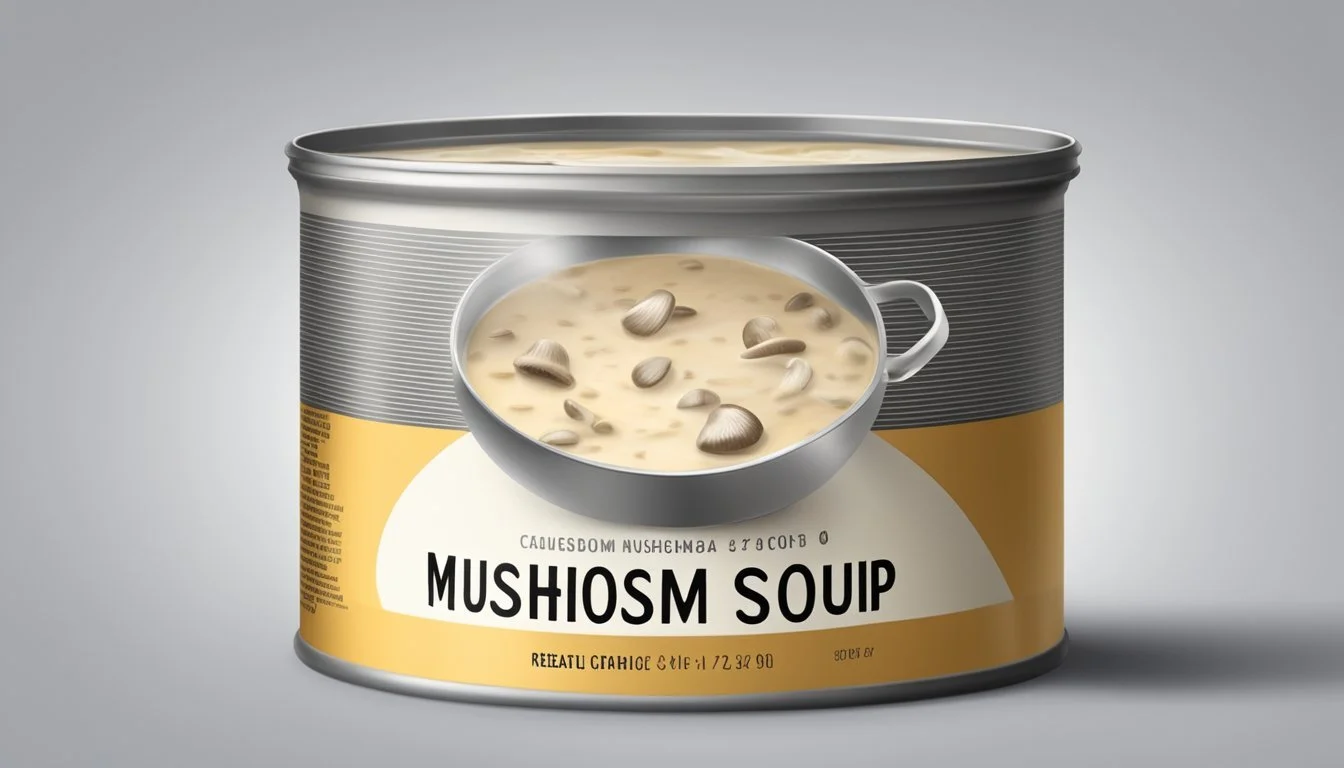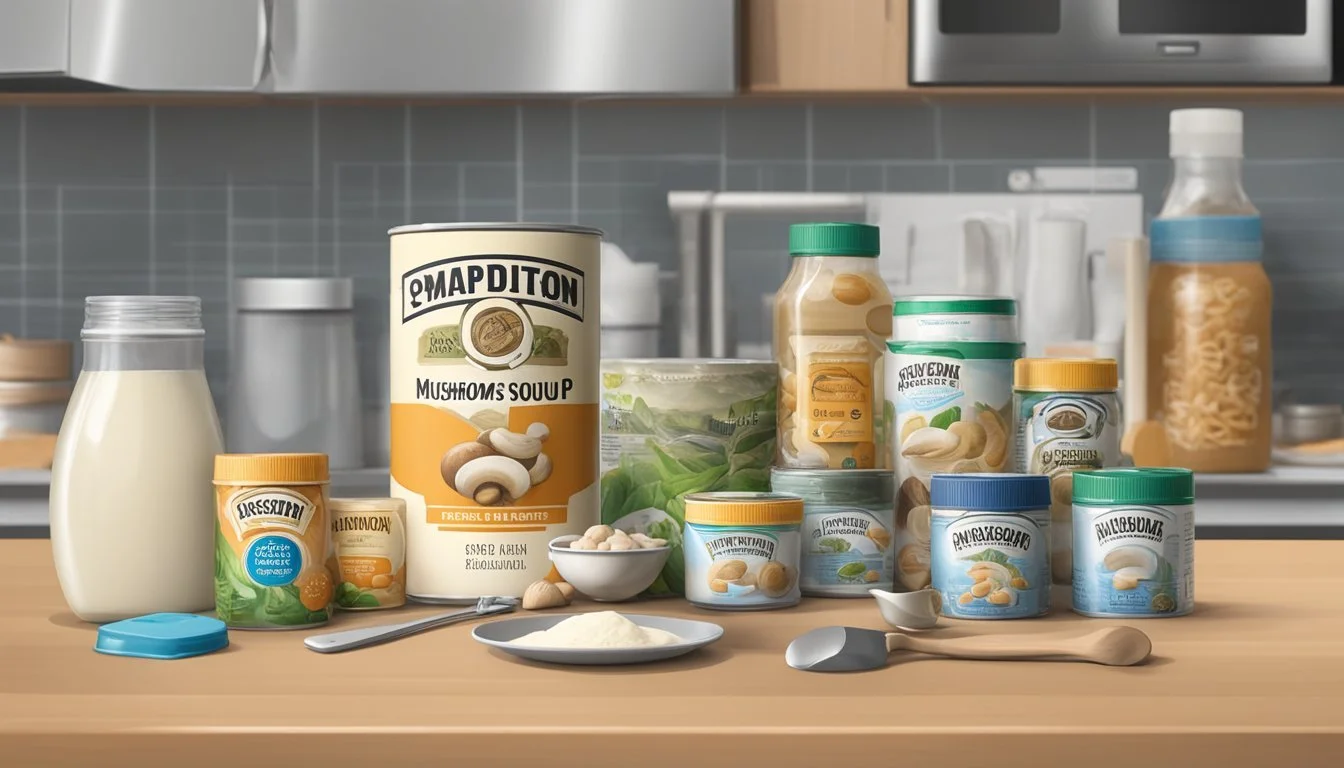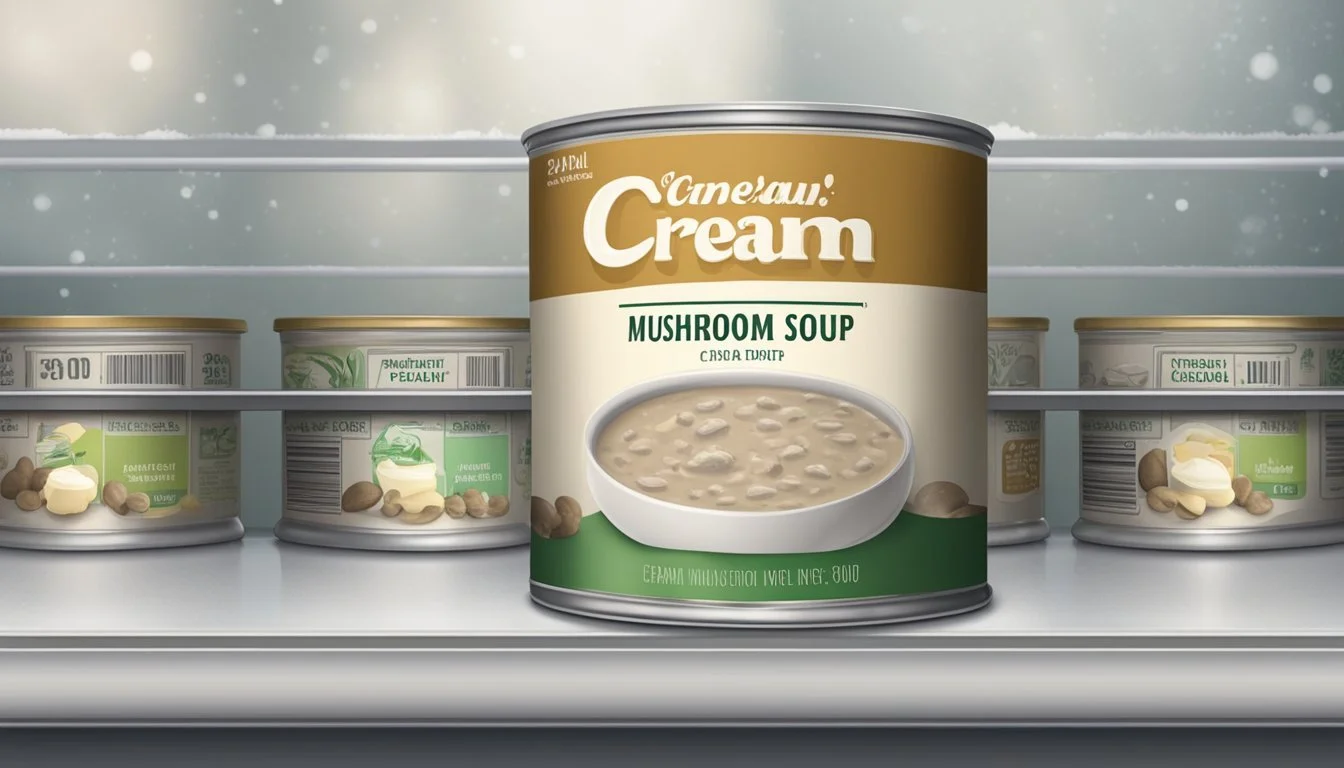Does Canned Cream of Mushroom Soup Expire?
Shelf Life and Storage Tips
Canned cream of mushroom soup typically has a long shelf life, lasting between 2-5 years if stored in a cool, dry place. The expiration date on the can is a good guideline for ensuring its freshness and quality. While it may be safe to consume the soup past this date, its taste and texture could be compromised.
To maintain its safety and quality, it is essential to store unopened cans properly and to check for any signs of spoilage. Once a can is opened, the soup should be transferred to an airtight container and refrigerated to prolong its usability.
Understanding the storage and safety aspects of canned cream of mushroom soup can help consumers maximize its shelf life while ensuring it remains enjoyable to eat.
Understanding Expiration Dates
Expiration dates can be confusing, but they are important for ensuring food safety and quality. The terms "best before," "sell-by date," and "expiration date" each play a unique role in this process.
Interpreting Date Labels
Expiration Date: Indicates the last date the product is safe to consume. This is critical for perishable items where safety can be compromised.
Best Before: Refers to the period during which the food product is at its peak quality. Consuming items past this date is generally safe, though the taste and texture may degrade.
Sell-By Date: This date is for retailers, indicating until when a product should be displayed for sale. It helps manage inventory but doesn't necessarily mean the product is unsafe after this date.
Guidelines: The USDA provides guidelines on storing and using food products. For canned goods like cream of mushroom soup, they often remain safe years past the best before date if stored in a cool, dry place.
Regulatory Standards
USDA Standards: The USDA sets regulations for labeling dates on food products. These guidelines help ensure food safety and proper handling.
Food Safety: Agencies require manufacturers to label products with dates to inform consumers about the safety and quality of the food. These dates are based on rigorous testing for spoilage and contamination.
Quality Assurance: Regulatory bodies work with manufacturers to determine the optimal labeling to help maintain product quality and safety standards. This ensures that consumers receive the best possible experience with their food purchases.
In conclusion, understanding these different labels is vital for making informed choices about food safety and quality, especially with canned goods like cream of mushroom soup.
Assessing the Quality of Canned Soup
Evaluating the quality of canned cream of mushroom soup involves checking both its appearance and smell. These indicators help determine if the soup is still good to consume.
Visual Inspection
Conducting a visual inspection provides the first clue about the condition of the soup. Discoloration can signal spoilage. Fresh cream of mushroom soup usually has a creamy, light beige hue. Any change to a darker color or the presence of mold might indicate it has gone bad.
Clumping is another sign to watch for. The texture should be smooth and consistent. If it appears unusually thick, lumpy, or the liquid has separated significantly, it might be past its prime.
Additionally, examine the can itself. Dents, rust, or bulging can compromise the safety of its contents. Don’t consume soup from a can that shows any of these warning signs.
Olfactory Indicators
Olfactory indicators, or smell tests, are critical for evaluating canned cream of mushroom soup. A fresh can should emit a pleasant, savory aroma, reminiscent of mushrooms and cream.
An off smell can be a strong warning sign. If the soup smells sour, rancid, or has a metallic odor, it may be unsafe to eat. This could be due to bacterial growth or chemical changes in the soup.
Sometimes, the smell can be subtle. Always take a cautious approach if anything seems amiss. When in doubt, it’s better to discard the soup than risk consuming expired or spoiled food.
Storage Conditions and Shelf Life
Proper storage can significantly impact the shelf life of canned cream of mushroom soup. Key factors to consider include storage location, temperature, and the condition of the can.
Optimal Storage Practices
For the longest possible shelf life, store canned cream of mushroom soup in a cool, dry place like a pantry. Ensure that the area is free from direct sunlight, as exposure to sunlight can affect the quality of the soup. Avoid storing cans in areas where the temperature fluctuates, as this can accelerate spoilage.
When storing canned food, inspect the cans for any damage such as dents or leaking, as these can compromise the contents. Shelf life is also affected by the integrity of the packaging.
Maximizing Soup Longevity
Typically, an unopened can of cream of mushroom soup can last between 2 to 5 years. This duration depends on the storage conditions and the brand. The soup should be kept at a stable temperature and away from moisture.
Once the can is opened, transfer any unused soup into a sealed container and refrigerate. Use within 3-4 days to ensure safety and quality. If freezing the soup to extend its shelf life, be sure to use appropriate containers suitable for freezing to prevent freezer burn.
After Opening: Handling and Usage
Proper handling of canned cream of mushroom soup after opening is essential for maintaining its quality and safety. Key considerations include refrigeration and consumption timelines, as well as effective storage practices for leftovers.
Refrigeration and Consumption
Once opened, canned cream of mushroom soup should be transferred to an airtight container to prevent exposure to air and contaminants.
Immediate refrigeration is crucial to keep the soup fresh. The recommended storage temperature is 40°F (4°C) or lower.
Under these conditions, the soup can typically be safe to consume within 3-5 days. It is important to check for signs of spoilage, such as sour smell, changes in texture, or mold growth before consumption.
Avoid using the original can for storage, as it can lead to metallic taste and accelerated deterioration.
Recommendations for Leftovers
For best results, any leftover cream of mushroom soup should be cooled quickly and promptly placed in the fridge.
Large amounts can be divided into smaller portions in shallow containers to cool more evenly and rapidly.
Labeling containers with the date of storage helps track the freshness of the leftovers. Reheating should be done thoroughly to at least 165°F (75°C) to ensure safety.
If the soup has been reheated more than once, it is advisable to discard any additional leftovers to minimize the risk of foodborne illness.
Recognizing Spoilage
Identifying spoilage in canned cream of mushroom soup is crucial to avoid health risks. Look for signs both on the can and within the soup to determine if it has gone bad.
External Can Damage
Inspect the can for any visible damage. Dents, bulges, and rust can indicate contamination. Rust could mean that the can’s integrity is compromised, allowing bacteria to enter.
Bulging cans are a concern; they might contain botulism, a serious foodborne illness. If any of these signs are present, it’s best to discard the can.
Internal Indicators of Spoilage
When you open the can, a foul odor is a strong indicator of spoiled soup. Discoloration, such as a grayish or greenish hue, often suggests mold or bacterial growth. The presence of mold is an absolute sign that the soup has gone bad.
Texture changes are another warning. If the soup has a slimy consistency, it signals contamination. Consuming spoiled soup can lead to foodborne illnesses, so it's essential to be cautious and discard any suspicious cans.
Freezing Cream of Mushroom Soup
Freezing cream of mushroom soup extends its shelf life and prevents waste. Properly storing and reheating it ensures the best texture and flavor.
Proper Freezing Techniques
To freeze cream of mushroom soup, start by allowing the soup to cool to room temperature. This prevents condensation from forming in the storage container.
Pour the cooled soup into airtight containers or freezer bags. Leave some space at the top for the soup to expand as it freezes. Removing as much air as possible from the freezer bags helps to prevent freezer burn.
Label the containers or bags with the date to keep track of freezing times. For the best quality, use the frozen soup within 2-3 months. If the soup contains dairy, consider adding a cornstarch slurry or beurre manié before freezing to help stabilize the texture.
Thawing and Reheating Instructions
Defrost the frozen cream of mushroom soup by transferring it from the freezer to the refrigerator. This gradual thawing process keeps the soup safe and helps maintain its texture. Allow it to thaw in the refrigerator for several hours or overnight.
For faster thawing, place the sealed bag or container in a bowl of cold water. Change the water every 30 minutes to ensure even thawing.
Once defrosted, reheat the soup on the stove over medium heat. Stir frequently to reincorporate any separated ingredients. If microwaving, use a microwave-safe container and heat in short intervals, stirring between each to avoid uneven heating. Avoid overheating to prevent curdling.
Nutrition and Health Considerations
Cream of mushroom soup, whether canned or homemade, presents various nutritional profiles and health implications. This section will examine the differences and concerns associated with each type, focusing on their ingredients and potential health impacts.
Canned vs. Homemade
Canned cream of mushroom soup offers convenience and a long shelf life. Typically, canned soup contains high levels of sodium and various preservatives to extend its storage life. These additives can diminish the nutritional value. Canned soup is fortified with B-vitamins and other nutrients, but the high sodium content often worries health-conscious consumers.
Homemade cream of mushroom soup avoids these preservatives, offering a fresher, more natural taste. Homemade varieties allow for greater control over ingredients, enabling cooks to minimize sodium and avoid additives. This can enhance the nutritional value and provide a healthier option, rich in natural vitamins and minerals.
Preservatives and Additives
Canned cream of mushroom soup often includes preservatives and additives to enhance flavor and prolong shelf life. Common preservatives include monosodium glutamate (MSG) and sodium benzoate, which can cause issues for sensitive individuals. High sodium levels—sometimes exceeding 50% of the daily recommended intake per serving—are prevalent in canned soups to maintain flavor stability.
Conversely, homemade soups generally lack these artificial preservatives. Using fresh ingredients means fewer chemicals and more natural nutrients, making homemade soups a healthier choice. Individuals focused on nutritional benefits and minimizing potential health risks frequently prefer homemade soup recipes.
Incorporating into Recipes
Canned cream of mushroom soup is versatile, suitable for various dishes like casseroles and sauces. Its convenience makes it a favorite in many kitchens.
Alternative Options
For those seeking to enhance homemade recipes, adding fresh mushrooms can significantly improve flavors.
Sauté cremini or button mushrooms in butter until golden brown. Then, incorporate them into the soup. This adds earthy, meaty flavors that elevate canned soup.
Other alternatives include blending herbs and spices like thyme or garlic powder.
For vegetarian options, consider using vegetable stock as a base. This offers a lighter taste and more control over sodium levels.
Exploring these alternatives can transform basic canned cream of mushroom soup into a gourmet experience.
Safe Disposal of Expired Cans
Proper disposal of expired cream of mushroom soup cans ensures safety and minimal environmental impact. Address when to dispose of them and the best recycling practices.
When to Dispose
Expired cans of cream of mushroom soup, if rusted or showing signs of leaking, should be disposed of immediately. Cans that are bulging or have compromised seals should also be discarded promptly.
When deciding to dispose of expired cans, consider that while some canned foods are safe to consume past the expiration date, damaged containers are risky. Signs such as dents, rusting, or an off smell signal the need for disposal.
Cans that have been stored under adverse conditions, such as extreme temperatures or high humidity, are more likely to degrade. Checking for these signs ensures that only safe products remain in your pantry.
Recycling and Environment
Dispose of expired cans responsibly to minimize environmental impact. Rinse the can to remove any remaining soup before recycling. This removes potential contaminants and makes recycling more effective.
Most canned containers are made from steel or aluminum, both of which are recyclable. Ensure that the labels and lids are removed before placing the cans in the recycling bin. Follow local recycling guidelines to ensure proper handling.
If the cans are not recyclable due to severe rusting or damage, dispose of them in the regular trash. For unopened but expired cans of cream of mushroom soup that appear intact, consider donating to food banks if they accept such items. This reduces waste and supports community needs.







